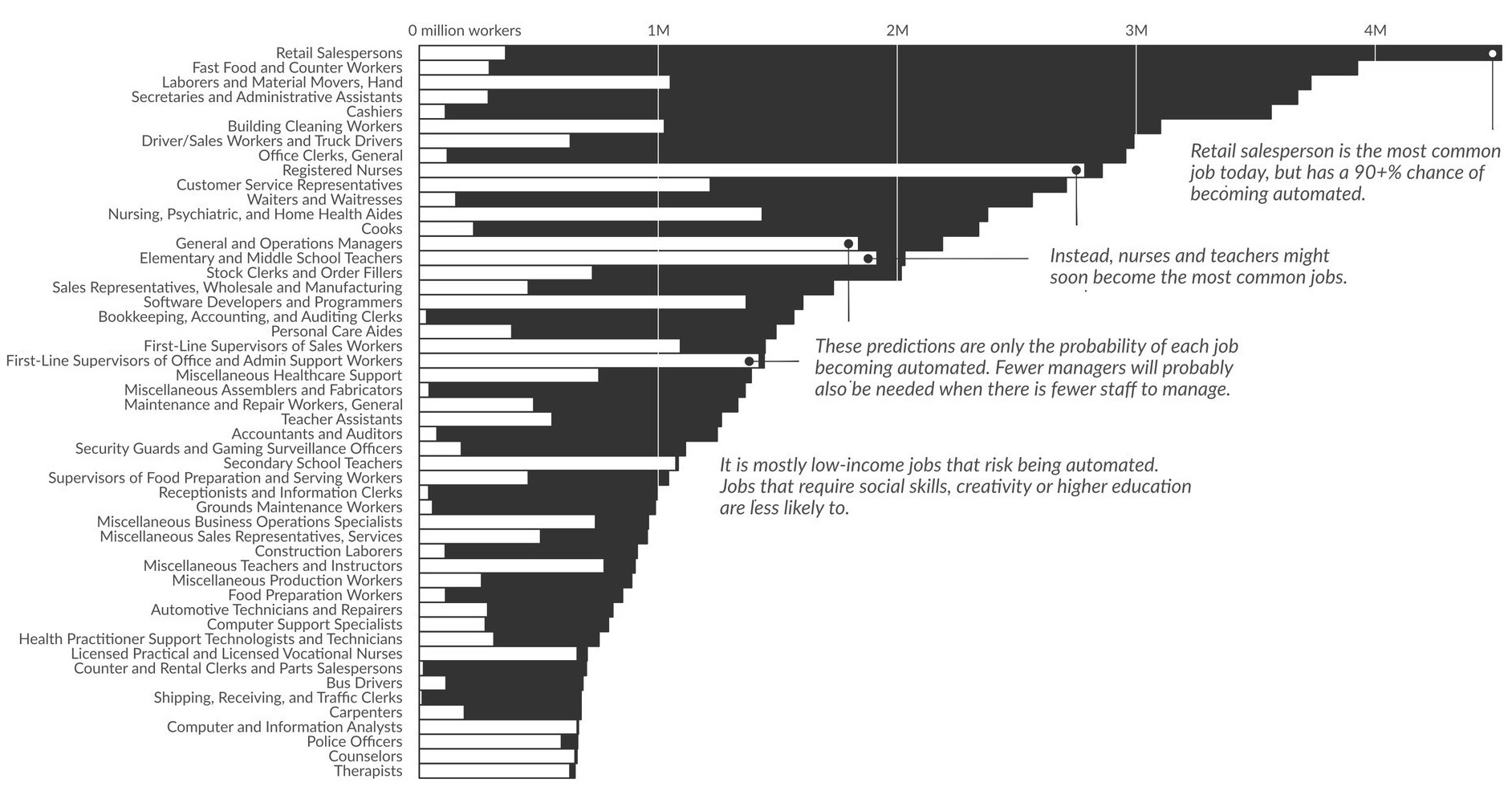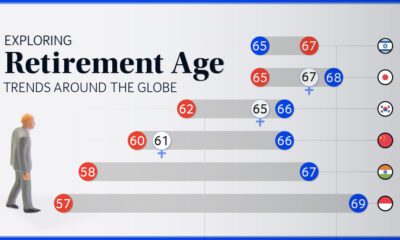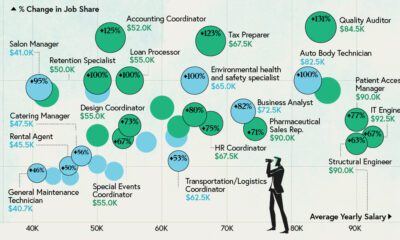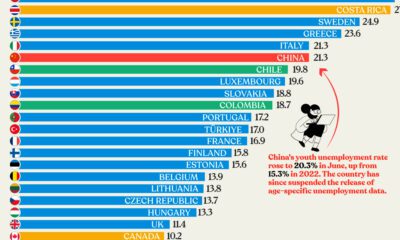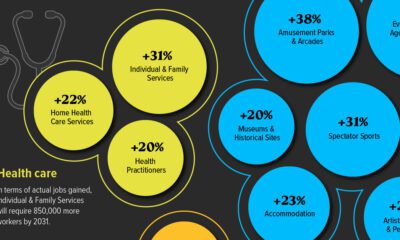Technology
Visualizing the Jobs Lost to Automation
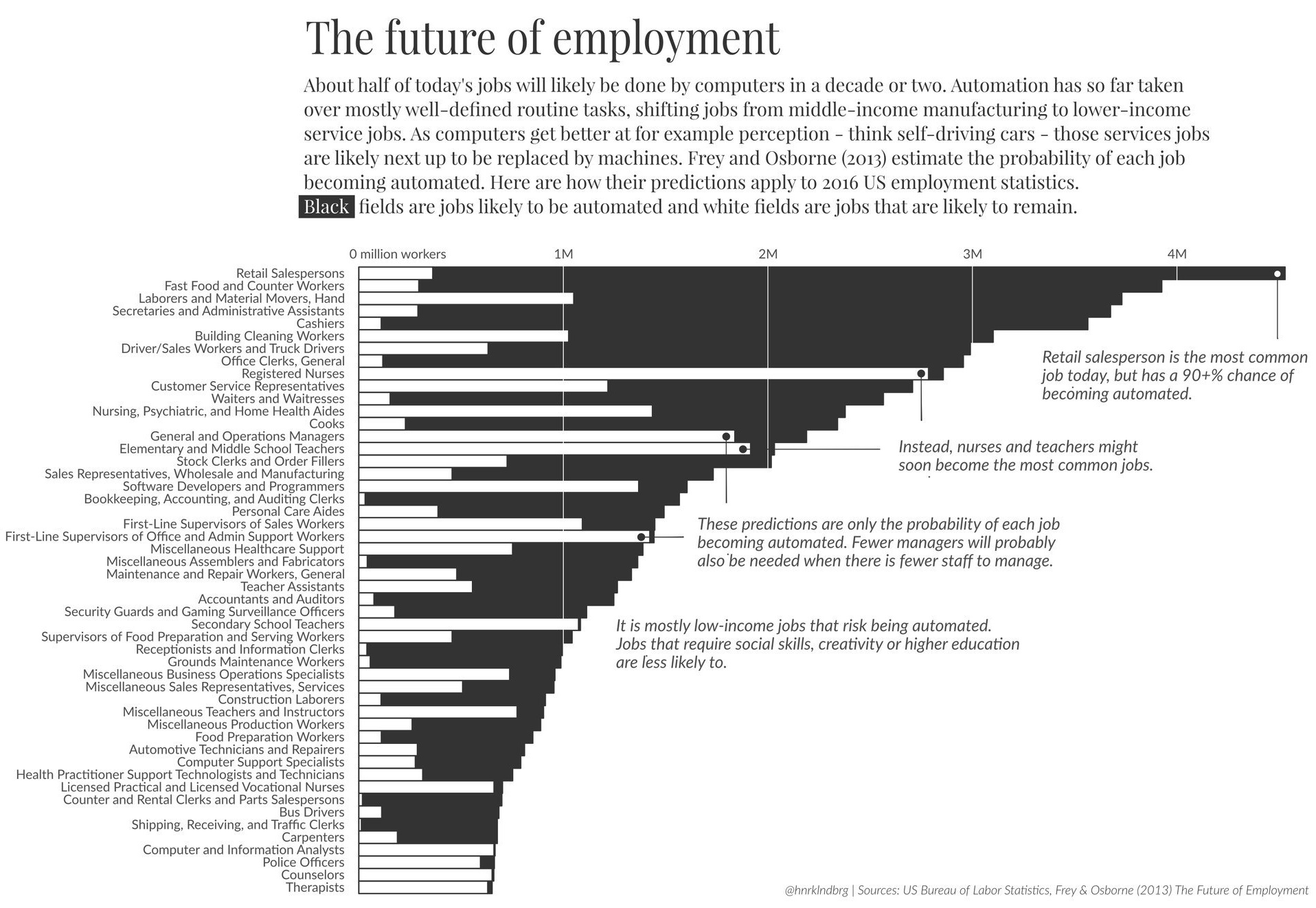
Visualizing the Jobs Lost to Automation
The employment landscape of the future will look very different than it does today.
While we’ve charted the automation potential of U.S. jobs before, today’s graphic from Henrik Lindberg perhaps tells the story more succinctly.
In plain black and white, it shows the jobs that exist today in contrast to the jobs that are expected to disappear as a result of automation in the workplace. Though, technically speaking, it is applying the probabilities of the widely-cited Frey & Osborne (2013) study to U.S. jobs as of 2016 to give an expected value to each job title.
A Different Landscape
In the near-future, many of today’s most common jobs may be changed profoundly. People working as retail salespersons, cashiers, fast food counter workers, and truck drivers will likely see opportunities in those fields dry up as automation takes place.
At the same time, jobs such as those in teaching and nursing are expected to stand the test of time, as they require empathy, creativity, and a human touch not yet available through machines. In the coming decades, it’s possible that these could even be professions that employ the most people overall.
Casualties of the Fall?
In the vastly different employment landscape of the future, the worry is that low income workers will have fewer opportunities available to them as technology comes into play.
The good news? Historically this has not been true. As an example, nearly 500 years ago, Queen Elizabeth I had a similar fear when she denied a patent for an automated knitting machine. The thought was that the machine would kill jobs, though eventually factories and companies adopted similar technologies anyways. With the lower prices, higher demand for knitted goods, and more capital for investment, jobs for factory weavers actually quadrupled in the coming years.
As we’ve seen over time, while machines destroy jobs, they also often create new ones.
Composition of U.S. Job Market over the Last 150+ Years
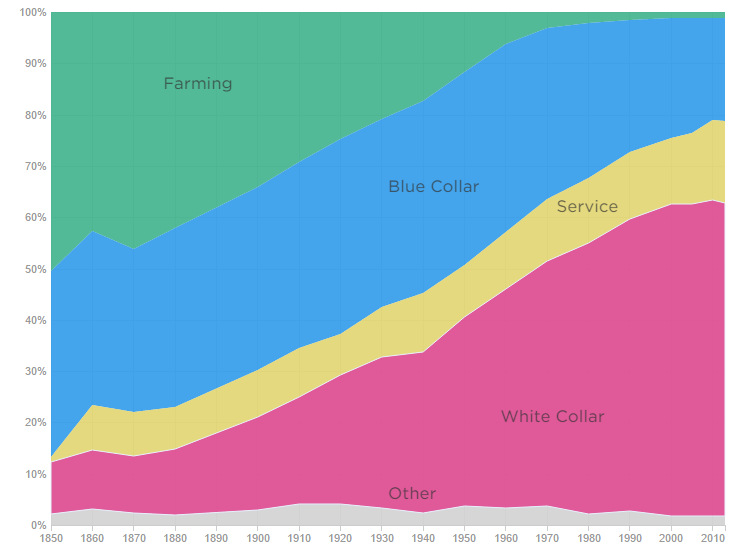
The bad news? It is now clear that agricultural jobs of the early 20th century were replaced with the white collar jobs of today. However, it is much more difficult to forecast out how some of the jobs of the future will be created, especially for low income workers.
The knitting example above certainly applies in some situations – but in others, it’s hard to say what will happen. For example, with millions of unemployed long-haul truck drivers, what roles will these people be taking in the future job market?
Even with costs of transportation and logistics going down, increased demand, and more capital to invest, it seems that there’s going to be a lengthy period of time where many of these people will have trouble finding work.
Do they join the company to help manage the many more trucks that are self-driving? It’s unlikely, and that is the part of the optimism about automation and future jobs that is the hardest to reconcile.
Technology
Visualizing AI Patents by Country
See which countries have been granted the most AI patents each year, from 2012 to 2022.

Visualizing AI Patents by Country
This was originally posted on our Voronoi app. Download the app for free on iOS or Android and discover incredible data-driven charts from a variety of trusted sources.
This infographic shows the number of AI-related patents granted each year from 2010 to 2022 (latest data available). These figures come from the Center for Security and Emerging Technology (CSET), accessed via Stanford University’s 2024 AI Index Report.
From this data, we can see that China first overtook the U.S. in 2013. Since then, the country has seen enormous growth in the number of AI patents granted each year.
| Year | China | EU and UK | U.S. | RoW | Global Total |
|---|---|---|---|---|---|
| 2010 | 307 | 137 | 984 | 571 | 1,999 |
| 2011 | 516 | 129 | 980 | 581 | 2,206 |
| 2012 | 926 | 112 | 950 | 660 | 2,648 |
| 2013 | 1,035 | 91 | 970 | 627 | 2,723 |
| 2014 | 1,278 | 97 | 1,078 | 667 | 3,120 |
| 2015 | 1,721 | 110 | 1,135 | 539 | 3,505 |
| 2016 | 1,621 | 128 | 1,298 | 714 | 3,761 |
| 2017 | 2,428 | 144 | 1,489 | 1,075 | 5,136 |
| 2018 | 4,741 | 155 | 1,674 | 1,574 | 8,144 |
| 2019 | 9,530 | 322 | 3,211 | 2,720 | 15,783 |
| 2020 | 13,071 | 406 | 5,441 | 4,455 | 23,373 |
| 2021 | 21,907 | 623 | 8,219 | 7,519 | 38,268 |
| 2022 | 35,315 | 1,173 | 12,077 | 13,699 | 62,264 |
In 2022, China was granted more patents than every other country combined.
While this suggests that the country is very active in researching the field of artificial intelligence, it doesn’t necessarily mean that China is the farthest in terms of capability.
Key Facts About AI Patents
According to CSET, AI patents relate to mathematical relationships and algorithms, which are considered abstract ideas under patent law. They can also have different meaning, depending on where they are filed.
In the U.S., AI patenting is concentrated amongst large companies including IBM, Microsoft, and Google. On the other hand, AI patenting in China is more distributed across government organizations, universities, and tech firms (e.g. Tencent).
In terms of focus area, China’s patents are typically related to computer vision, a field of AI that enables computers and systems to interpret visual data and inputs. Meanwhile America’s efforts are more evenly distributed across research fields.
Learn More About AI From Visual Capitalist
If you want to see more data visualizations on artificial intelligence, check out this graphic that shows which job departments will be impacted by AI the most.
-

 Mining1 week ago
Mining1 week agoGold vs. S&P 500: Which Has Grown More Over Five Years?
-

 Markets2 weeks ago
Markets2 weeks agoRanked: The Most Valuable Housing Markets in America
-

 Money2 weeks ago
Money2 weeks agoWhich States Have the Highest Minimum Wage in America?
-

 AI2 weeks ago
AI2 weeks agoRanked: Semiconductor Companies by Industry Revenue Share
-

 Markets2 weeks ago
Markets2 weeks agoRanked: The World’s Top Flight Routes, by Revenue
-

 Countries2 weeks ago
Countries2 weeks agoPopulation Projections: The World’s 6 Largest Countries in 2075
-

 Markets2 weeks ago
Markets2 weeks agoThe Top 10 States by Real GDP Growth in 2023
-

 Demographics2 weeks ago
Demographics2 weeks agoThe Smallest Gender Wage Gaps in OECD Countries
